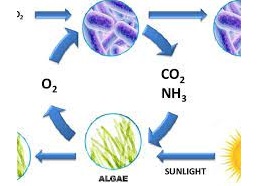Phycoremediation in Wastewater Treatment

DOI:
https://doi.org/10.54060/JMCE/001.02.002Keywords:
Phycoremediation, Microalgae, Wastewater, Removal, Trace Metals, Nitrogen, TreatmentAbstract
The simplest definition of phycoremediation is the use of algae to treat wastewater. Water as a commodity is very scarce and following a downward trend with every passing day. The Middle East and North Africa region, accommodates almost 5% of the world’s population but contain less than 1% of the world’s annual renewable freshwater. The cities are growing at a rate of 4% every year, so this is only going to worsen the demand and supply of water. Hence the use of algae (microalgae and marine macro algae, commonly known as seaweeds) particularly microalgae can help treat the water efficiently and cater to the demand of the growing population. The omnipotent like stature of algae and its adaptation to multifarious habitats, makes them tolerant to a wide range of environmental conditions, including nutrient levels. The algae can work as a carbon-reducing system that can convert carbon dioxide into oxygen through photosynthesis, due to its handling of adverse conditions we can use microalgae for bioremediation of wastewater and the biomass produced during the process can serve as food, fertilizers, and of late, biofuels.
Downloads
References
N. Moondra, R. A. Christian, and N. D. Jariwala, “Phycoremediation: An advanced treatment approach for domestic wastewater,” in Lecture Notes in Civil Engineering, Singapore: Springer Nature Singapore, 2023, pp. 57–63.
P. H. Rao, R. R. Kumar, and N. Mohan, “Phycoremediation: Role of algae in waste management,” in Microorganisms for Sustainability, Singapore: Springer Singapore, 2019, pp. 49–82.
Anqi Li, Zhiyuan Liu, Yong-qin Wang “Effects of optimized encapsulation formulations of microalgae and bacteria on the nitrogen and phosphorus removal from wastewater,” Water Pollut. Treat., vol. 09, no. 04, pp. 155–165, 2021.
A. Worku and O. Sahu, “Reduction of heavy metal and hardness from ground water by algae,” Journal of Applied & Environmental Microbiology, vol. 2, no. 3, pp. 86–89, 2014.
J. F. Malina and Y. A. Yousef, “The Fate of Coliform Organisms in Waste Stabilization Ponds,” Journal (Water Pollution Control Federation), vol. 36, no. 11, pp. 1432–1442, 1964.
D. Voltolina, “Growth of Scenedesmus sp. in artificial wastewater,” Bioresour. Technol., vol. 68, no. 3, pp. 265–268, 1999.
H. Eccles, “Removal of heavy metals from effluent streams — Why select a biological process?” Int. Biodeterior. Biodegradation, vol. 35, no. 1–3, pp. 5–16, 1995.
C. Garbisu, I. Alkorta, and U. de Biofísica, “Basic concepts on heavy metal soil bioremediation,” 2003.
C. J. Soeder, “Massive cultivation of microalgae: Results and prospects,” Hydrobiologia, vol. 72, no. 1–2, pp. 197–209, 1980.
N. Akhtar, M. Iqbal, S. I. Zafar, and J. Iqbal, “Biosorption characteristics of unicellular green alga Chlorella sorokiniana immobilized in loofa sponge for removal of Cr (III),” J. Environ. Sci. (China), vol. 20, no. 2, pp. 231–239, 2008.
V. K. Gupta and A. Rastogi, “Biosorption of lead from aqueous solutions by green algae Spirogyra species: kinetics and equilibrium studies,” J. Hazard. Mater., vol. 152, no. 1, pp. 407–414, 2008.
M. A. R. Shaikh and D. V. M. Inamdar, “Study of utilization of wastewater in concrete,” IOSR j. mech. civ. eng., vol. 13, no. 04, pp. 105–108, 2016.
A. Agarwal, D. Ojha (2021) Green Mortar by Partial introduction of Shredded Waste Plastic. Journal of Mechanical and Construction Engineering,1 (1) vol. 1, no. 1, pp. 1–4, 2021.
S. Tomar et al. “Statistical analysis of distress management in existing buildings,” Journal of Mechanical and Construction Engineering (JMCE), vol. 1, no. 1, pp. 1–4, 2021.
























